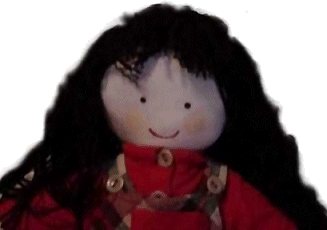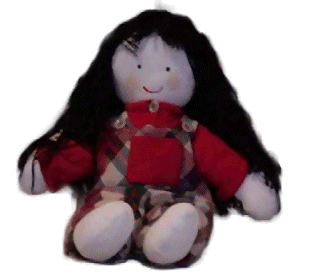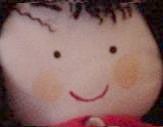|
|
|
|
La bambola di pezza è un classico per le mamme un po' nostalgiche e per bambine che riescano a sottrarsi alle Barbie.
La bambola di pezza è fatta per tutti quelli che pensano ancora che un bambino debba sviluppare un rapporto affettivo con i giocattoli.
Certo non possiamo impedire che qualcuno prima o poi commercializzi
delle bambole di pezza con dentro un microprocessore, che parla con il
bambino, cerca di educarlo e magari, già che c'è, fa anche un po' di
psicoterapia standard.
The patch doll is a classic for nostalgic mothers and for little girls that manage to get away from Barbie.
The patch doll is made for all those who still thinks that a child should develop a feeling for the toys.
Of course we canít avoid that someone, sooner or later commercialise the patch dolls with a micro-chip inside which makes it talk to the child, trying to educate, and why not, also to practice a bit of standard psychotherapy. |
 |
|
|
|
|
Nel frattempo, per quei bambini e quelle mamme che hanno ancora la fortuna di avere qualcuno che può cucire per loro una bambola di pezza con il vestititino fatto con la camicia smessa del babbo, ecco un modello di bambola piuttosto facile.
Potete usare qualunque stoffa di cotone o maglina per fare il corpo, l'unica necessità è che la stoffa sia piuttosto leggera e morbida.
Se avete della stoffa bianca potete tingerla nel tè per scurirla un poco perché assomigli di più alla pelle.
Meanwhile, for all those children and mothers who still have someone able to sew for them a patch doll with the little dress made by dadís old shirt, here You are a quite easy pattern for a doll.
You can use any cotton or jersey cloth for the body, as long as the fabric is quite light and soft.
If You have a white cloth, You can colour it in some tea to make it darker and make it look more like human skin.
|
|

|
Fotocopiare o stampare le parti ingrandite del
modello ingrandendo fino alla dimensione desiderata.
Appoggiare i modelli sulla tela di cotone e ritagliare considerando 1/2 cm in più per la costura. Cucire le varie parti del corpo: gambe e braccia e busto-testa separatamente.
Increspare il dietro della testa fino ad incontrare le dimensioni della faccia e cucire la faccia stessa.
Copy or print the enlarged parts of the pattern, enlarging until the size You wish.
Place the pattern on the cotton cloth and cut, leaving ½ cm for the margin. Sew the different parts of the body: legs, arms and bust-head separately.
Collect the cloth on the back of the head until You get the correct dimensions of the face and sew the face. |
|
|
|
|
Attaccare la faccia busto sul davanti (sul collo).
Cucire il busto lasciando fenditure per l'inserimento di braccia, lasciando aperta la parte sul basso per inserire le gambe. Riempire la testa ed il busto con l'ovatta sintetica.
Riempire le braccia e le gambe. Una volta riempiti gli arti fare un filza a 1/2 cm dalla fine per chiudere. Le gambe vanno chiuse con le costure al centro di modo che i piedi vengano girati in avanti e non di lato.
Attach the face on the front of the bust.(on the neck).
Sew the bust leaving openings for the arms, and on the bottom for the legs.
Fill the head and the bust with synthetic wadding.
Fill the arms and the legs. Once filled the limbs, make a running stitch 1/2 cm from the end to close. The legs are to be closed with the borders in the middle to have the feet pointing forward and not side wards.
|
|
|
|
|
Inserire le gambe sul fondo del busto e cucirle al busto a mano con un soppunto fitto. Stesso procedimento per le braccia. I capelli sono fatti di lana. Se volete i riccioli lavorate la lana a maglia, stiratela e poi disfatela oppure usare la lana bouclè.
Avvolgere la lana sul lato lungo di un libro (dimensioni dipendenti da come volete lunghi i capelli) facendo una matassina e tagliatela su un lato.
Ci sono diversi modi per fissare la lana-capelli alla testa. Si può fare un caschetto all'uncinetto molto rado a maglia alta o maglia rete (dello stesso colore dei capelli), fissarlo alla testa e poi intrecciare i fili alla trama dell'uncinetto.
Attach the legs at the bottom of the bust and sew them with small loose stitch. Same procedure for the arms. The hair is made by wool. If You want curly hair, You have to knit the wool, iron it and then loosen it, or alternately use bouclè wool.
Wrap the wool around a book (dimensions depending on how long You wish the hair to be), making a yarn and then cut it along the side.
There are different ways to stick the wool-hair onto the head. You can make a helmet with a very loose crochet work with high stitch or net stitch (same colour as the hair), stick it to the head and then braid the wool in the crochet work. |
 |
|
|
|
Alternativamente prendere una striscia di fiselina adesiva e cucire sul centro i capelli (divisa). Fissare la fiselina sulla testa con il ferro e fermare i capelli uniformemente con ago da lana con piccoli punti. Tagliare la frangia sul davanti più corta.
Per i vestitini potete usare quello che volete. La manica di una camicia va bene per il vestitino nella dimensione della bambola riportata nel
modello.
Alternately use a adhesive cloth and sew the hair on the centre. Attach the cloth to the head with the iron and sew on the hair, using a wool needle. Cut the fringe on the front shorter.
For clothes You can use anything You want. A shirt sleeve would be OK for the dress, for a doll of the dimensions of the
pattern. |
|
|
|
|
 |
Per la faccina potete dipingerla con colori da stoffa o colori acrilici che vanno poi stirati con un panno sotto il ferro, per fissarli.
Se siete brave potete anche ricamare occhi bocca e guancine rosa.
Adesso basta solo cominciare a giocare a mamme ... un gioco che non va più molto di moda perché per i nostri bambini non è divertente giocare alle mamme stressate.
For the face You can colour it with fabric colours or acrylic colours that are to be ironed with a cloth under the iron to fix them.
If You are very handy You can sew the eyes, moth and red cheeks.
Now all You have to do is start playing at mothers, something that isnít that much in use anymore because our children doesnít like playing at stressed mothers.
|






















